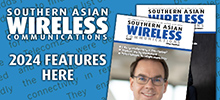26 August 2021

Kevin Graham, director, Australasian Critical Communications Forum-ACCF
Last quarter, the TCCA chairman stressed the importance of continuing global efforts in evolving open standards in both the mission critical capability on broadband networks (private and carrier) and also enhancing the existing digital narrowband standards (TETRA, P25, DMR) to ensure seamless interoperation can be achieved across networks, between devices and with critical control centres.
As populations grow, cities swell and man-made and natural disasters become more frequent, so also is the demand for critical services and therefore critical communications capability that supports service delivery. This includes public protection and disaster response and vital utility services including public access communications, transportation, healthcare, education and other government/industry services that underpin the general economy of nations. The advancement of critical networks is essential to address the increasing demands coming from end users for voice and data functionalities in resilient, secure and more interoperable ways.
An array of multivendor solutions and devices based on TETRA, P25, Tetrapol (and recently DMR and Chinese equivalent, PDT) have evolved. Significant and ongoing investment and deployment of these technologies occurred as older analogue deployments were replaced from the mid 1990s/2000s across APAC.
In government agencies and public safety we have seen major cities, provinces and several national shared government Radio Networks (GRN) deployed using these standards. South Korea, Hong Kong, Singapore, Malaysia and Australian states are all longstanding examples where shared GRNs replaced individual agency analogue networks and improved levels of intra and inter-agency critical communications across their respective populations. A similar situation has prevailed in many high-density cities in India, China, Philippines and Indonesia. Digital land mobile radio has also enjoyed widespread adoption in the public and private transport sector where Singapore, Hong Kong, India, Thailand, Malaysia, China, South Korea, and Australia have extensive deployments. The utility sector, municipal governments, and shared public access networks servicing needs of general industry and local government are significant too. Mining, resources, oil and gas (including LNG) are another major vertical market along with hospitals, education, casinos, conference venues and stadiums. Events such as F1 and Moto Grand Prix, Olympics, and International government forums have relied on these digital LMR technologies for event management, security and operations. These existing users continue to enhance and refresh networks and devices and new deployments continue. Beyond the core individual, broadcast and group voice call facilities there has been increased use of inherent data functionalities such as messaging, short-data applications, location-based reporting, geo-stamping of data, geo-fencing applications, man-down / lone worker, image transfer, SCADA and telemetry data transmission.
Many in these sectors have commenced or are interested in complimenting their LMR networks with wireless broadband to enable data transfer requiring higher speed data (video, imaging, push/pull information, and internet access). The mining sector has commenced some deployments of private LTE to support autonomous mining vehicle operations amongst other applications. Within government, transport and general industry and enterprise sectors there is clearly growth occurring for proprietary “over the top” voice and data applications using existing LTE carrier networks in the absence of availability of 3GPP compliant mission critical MCx (MCPTT, MCData and MCVideo) on most carrier networks.
South Korea completed the first three phases of a nationwide public-safety network, SafeNet, that commenced in 2018 after several years of planning, preliminary design and spectrum allocation. In March 2021 full systems acceptance was commemorated allowing the commencement of active service including 3GPP compliant Release 13 MCPTT functionality. The network core and operation centers are fully redundant meeting the specific needs of agencies.
New Zealand’s emergency services currently use voice-centric, mostly analogue government-owned and operated networks. A Next Generation Critical Communications (NGCC) Public Safety Network is now under tender evaluation stage. NGCC-PSN will replace existing disparate radio networks with a single nationwide secure digital radio service, and prioritised commercial cellular broadband capability in urban, highway and rural areas commonly accessed by Emergency Services. Secure digital radio will provide voice and messaging services in many areas where cellular services are not available.
In Australia, the New South Wales government, on behalf of all state and territory governments and the Australian Government have committed to work with Nokia, TPG Telecom and SingTel-Optus, to develop and test technology in a “proof of concept” trial until mid-2022. This trial will help shape the design of the national platform for emergency service communications that is contemplated to rollout in phases from 2023.
Clearly, MC LTE is gaining momentum in APAC and pathfinding projects here and in Europe and USA provide valuable lessons to others in this region. Regulatory and spectrum access policy have a major bearing on options for delivering MC broadband to government and industry users while supporting existing extensive investments in LMR. The strategies to reach implementation, require significant advance planning including determination of the solution delivery models be that dedicated network v’s hybrid or carrier MNO/MVNO approaches.
One thing certain is that advancing and commercializing open standards based eco-systems will be crucial for competitive and economic availability of multi-vendor mission critical LMR and LTE capability. Critical responders deserve modern communication tools to improve their effectiveness in protecting and serving all citizens.
TCCA/ACCF welcomes new member organizations from APAC to participate in shaping our regional future.






